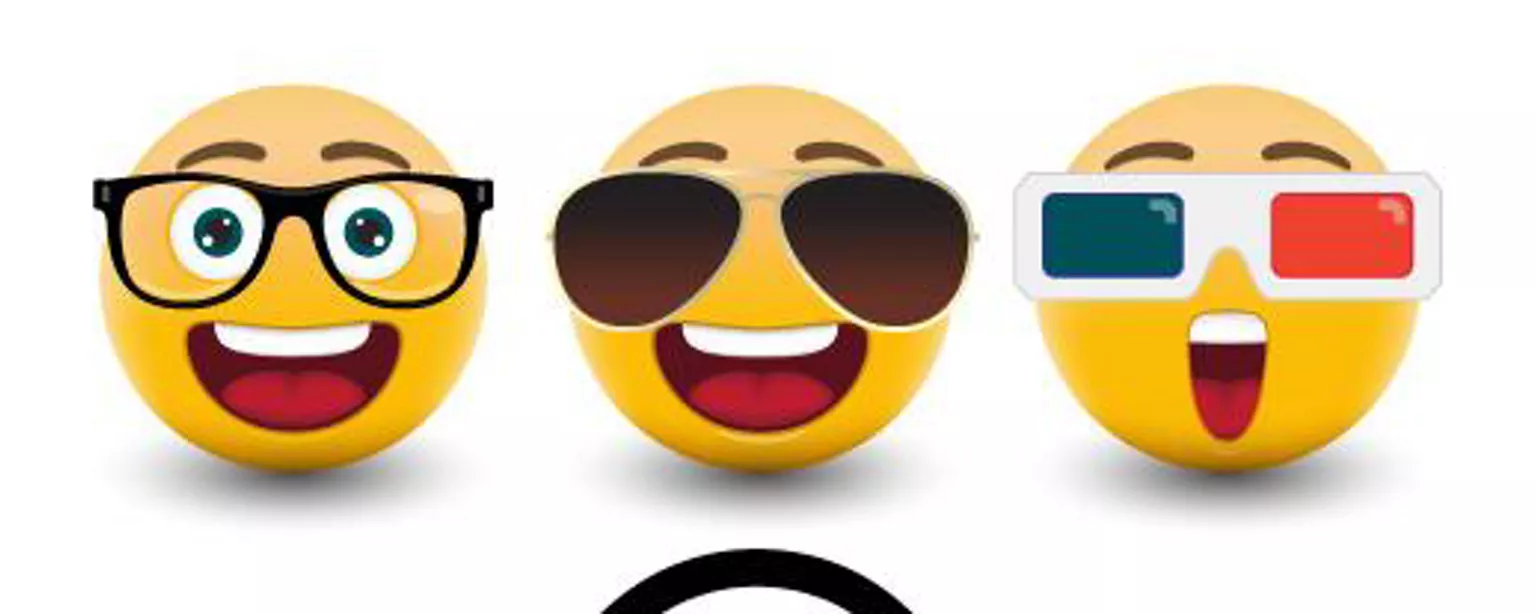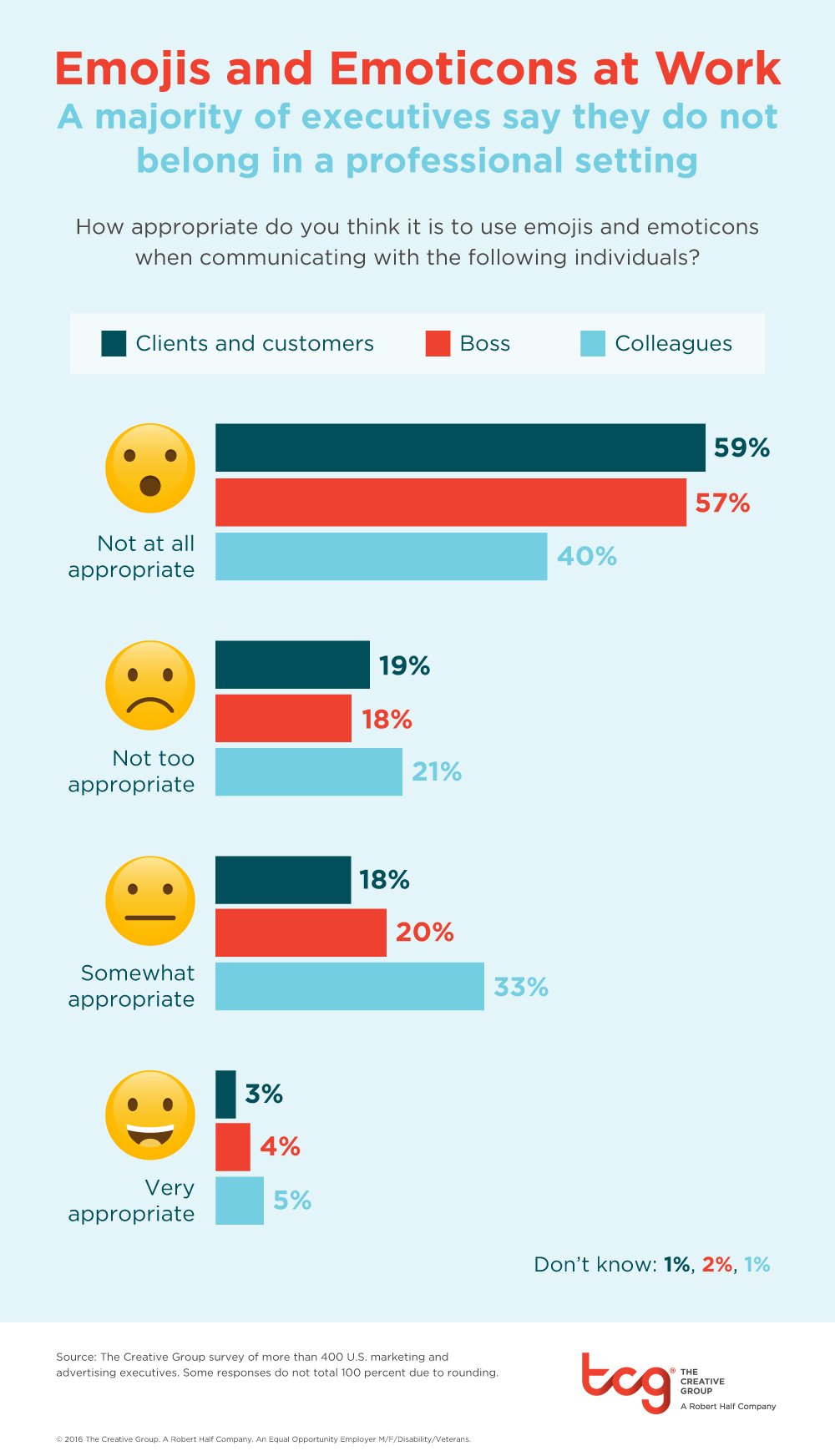Are you an avid emoji enthusiast? You’re certainly not alone. But what about using emojis in the workplace? Is it OK to send that funny smirking face, or could emoji usage be considered a thumbs down in a professional setting?
In today’s communication landscape, emojis allow people to visually express themselves and convey emotions that might be difficult to deliver through words alone. Many companies use emojis in creative ways to boost their brands online and connect with target audiences, but what’s the proper protocol for using emojis when communicating with your boss, colleagues and clients?
According to a recent survey by The Creative Group, a majority of marketing and advertising executives said emojis and emoticons are not appropriate in a professional setting. (See infographic below.) We decided to explore this further by getting the thoughts of a branding expert and the opinion of a noted business etiquette advisor.
Two views on emojis
We first chatted with Jozlynn Rush, social and digital experience manager at Taco Bell, a company well known for its emoji usage.
In your opinion, is it appropriate to use emojis when communicating in the workplace?
Jozlynn Rush: It all depends on your company’s culture and the relationship you have with your colleagues and clients. Emojis can be an effective way to add emotion or tone to a conversation that’s happening digitally where sometimes words can be misunderstood. But there’s a time and a place for using emojis in workplace communications. Email tends to be a bit more formal. However, communication tools like Slack actually encourage the use of emojis with features that allow you to add a reaction emoji to a comment or post.
Are there specific emojis creative professionals should try to avoid in workplace communications?
JR: I wouldn’t use an emoji I don’t know the meaning of, and I would stay away from emojis that could be easily misinterpreted.
Your company is known for embracing emojis. How do you incorporate them into your interactions with customers?
JR: At Taco Bell, we use emojis as part of our daily social media engagement strategy. Connecting with fans on our social media channels as a friend would is really important to us because it helps build deeper relationships with them. We use emojis to add emotion and fun to conversations.
We’ve heard that Taco Bell was the driving force behind getting an official taco emoji added. Is that true?
JR: In 2015, Taco Bell was receiving a lot of tweets from fans asking us why a taco emoji didn’t exist. It was a valid question, so we decided to create a Change.org petition asking the Unicode Consortium to add a taco emoji. Well, 33,000 signatures later, it happened and the taco emoji was added to the emoji keyboard. To celebrate, Taco Bell partnered with Twitter to create the Taco Emoji Engine. All you have to do is tweet @TacoBell the taco emoji plus any other emoji and you will receive a custom piece of content combining both emojis. The Taco Emoji Engine was a great way not only to celebrate the taco emoji being added but also to get consumers engaging with the brand and exploring new emojis.
We also consulted etiquette expert and author Daniel Post Senning of The Emily Post Institute to get his opinion on the topic of using emojis at work.
Do you think emojis belong in a professional setting?
Daniel Post Senning: You really need to think about what the goals and intentions for your communication are in order to determine what is appropriate, especially in a work setting. I tend to tell people that it’s best to defer to a more formal standard in terms of business communications. That formal standard means employing traditional communication like correct grammar, spelling and word choice, but does not include emojis.
Are there any instances where the use of emojis at work is acceptable?
DPS: If there is a colleague that you have a good rapport with and you can determine how each other is communicating via emojis, then it’s appropriate. However, if you don’t know someone yet, the goal is going to be the clarity of communication — making sure that you’re saying what you mean and you’re meaning what you say. When you start using emojis, the potential to be misunderstood tends to grow. That’s why I advise being cautious.
Are there specific emojis you should try to avoid in workplace communications?
DPS: When communicating at work, I want to make sure that I’m saying what I mean and that it’s going to be interpreted as closely to that as possible. Just like an emoji, a classic example of a commonly used expression that you’d think would be a given is “LOL.” Did the sender intend that to mean “laugh out loud” or “lots of love”? Using common emojis or expressions in the workplace can easily become confusing and shift the focus off the quality of your work and the content of your word.
What’s a general rule of thumb if an employee is debating whether to use emojis in a particular situation?
DPS: If you are ever sitting there with a question in mind of whether or not a type of communication is appropriate, in business situations it is best to go with your cautionary voice. Think about how the person on the other end will receive your emoji-encrypted message.
Emojis and Emoticons at Work
A majority of executives say they do not belong in a professional setting
How appropriate do you think it is to use emojis and emoticons when communicating with the following individuals?
| Clients and customers | Boss | Colleagues | |
|---|---|---|---|
| Not at all appropriate | 59% | 57% | 40% |
| Not too appropriate | 19% | 18% | 21% |
| Somewhat appropriate | 18% | 20% | 33% |
| Very appropriate | 3% | 4% | 5% |
| Don’t know | 1% | 2% | 1% |
Sources: The Creative Group survey of more than 400 U.S. marketing and advertising executives. Some responses do not total 100 percent due to rounding.
© 2017 The Creative Group. A Robert Half Company. An Equal Opportunity Employer M/F/Disability/Veterans.
The bottom line
While there are differing opinions on the use of emojis at work, communication is ultimately about serving relationships and connecting us in ways that are meaningful. Emojis can certainly be a way to enrich communication, but only if we employ caution and common sense.
For more career tips, subscribe to our blog now!








